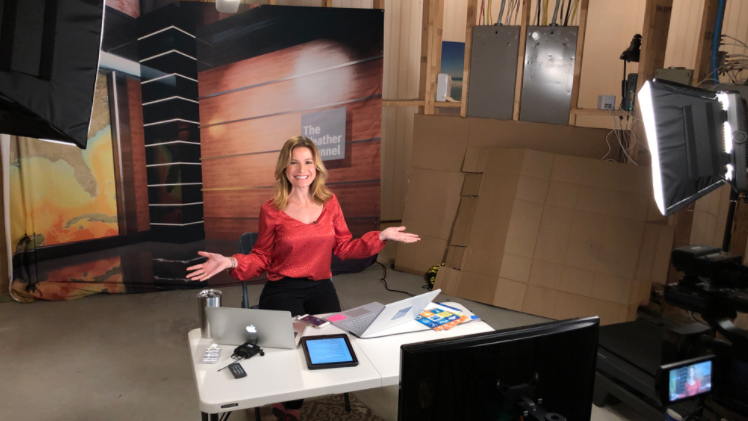
16 Apr The Weather Channel Finds Its Pandemic Shelter
By Michael Depp
As veterans of extreme weather coverage and robust remote production, The Weather Channel was ready for the storm the coronavirus brought to the industry. Network President Tom O’Brien says little has been upended by the pandemic, though the channel is now programming more science lessons for families sheltering at home.
As anyone who ever turned in to The Weather Channel’s extreme storm coverage will know, its people are tough.
The picture of a brightly-raincoated correspondent shin deep in floodwaters and lashed by howling storm bands is a fixture of our weather-wrought disasters. But in the quieter calamity of the coronavirus, the network has held just as sure a footing.
In an interview with TVNewsCheck Editor Michael Depp, Tom O’Brien, The Weather Channel’s president and EVP of Allen Media, its parent company, says long experience with remote production under duress has held the network in good stead for the current crisis. Other than readying about 90% of its workforce to work remotely, he says programming has continued unabated with the addition of new hourly segments targeted to kids now schooling from home.
O’Brien says the network even managed to pull through a planned traffic system change while gearing up for the coronavirus’ deadly impact.
An edited transcript.
Have any of your employees tested positive?
Knock on wood, we have been lucky. Our team continues to be healthy.
What percent of your staff is now working from home?
I would say 90% have the capability of working at home. We have gotten a lot of our folks out. We have minimal crews and have found a way to do a lot of what we do in studio in a remote fashion.
How involved was that as a process?
We had some of it in place just being a 24-hour news network used to covering storms and significant weather events. We have infrastructure in place that can help our teams in remote situations with regards to bandwidth and VPN access. We are used to working in extreme situations in the field, and that knowledge has helped us greatly as we have applied it to what we are doing on the pandemic front.
One of the harder things are the graphics. Are you capable of maintaining that same level of graphic presentation if you end up with most of your people doing their reporting from home?
Absolutely. We are doing a lot of it now. We have systems in place that keep the network redundant in a number of scenarios, this being one of them.
Who is still left at the facility? Who is indispensable to be there?
A lot of our crew is indispensable. As we look at crews, we have limited meteorologists between studios and home. We have small production crews that are physically in control rooms and we have cut the number of people in there so that we have plenty of room for people to work. We have a number of different places where we can move people around to prevent contact so that we can socially distance while they are doing their jobs.
Are your anchors mostly still working from the studio?
We have a mix. We are doing more remote, so we can put people in different studios. We have people spread out more. We have fairly large production areas and are able to set up a work environment that makes sense for the times that we are in.
Are those remote locations always your staffers’ homes?
We have been focusing right now on our meteorologists’ homes. We have just about all our meteorologists with in-home setups. This is a team that is used to being on the air for hours at a time talking about weather patterns and translating sophisticated weather data into understandable information. The good news is this is what they do on a day in, day out basis.
We have our graphics, we have a camera and remote package that we have perfected over the years with some of our field crews applying that now to the in-home setup. It has helped a great deal.
How will you handle an extreme weather event differently if one happens while you are in this largely remote configuration still?
We have already had it. We had significant tornados in Alabama. We have some very sophisticated modeling tools and our meteorologists from various locations have been able to follow the storm and provide the necessary warnings.
Our localization capabilities are still fully functional so our ability to isolate the network and find very specific storm-related information in effected areas remains intact. In those events, there is a team of stringers in the field that we use on a regular basis that continue to operate, so it hasn’t affected our ability to be accurate and to cover storms that people need to know about.
The Weather Channel was in the process of introducing some very complex immersive graphics into much of its broadcasting recently. How has that been impacted?
We are doing a little bit of it. Right now that is not the priority. Our priority is making sure that we are keeping our team safe and we are continuing to provide the level of forecasting and weather news information and science that we are known for.
We have added some educational programming. We are trying to use our scientists, understanding that there are a lot of people at home with kids trying to home school. So we are providing some additional programming, doing science experiments. The fact that we are a network that you can watch with your kids is something that we take seriously, and we have found a way to provide a very distinct need in the marketplace right now.
How has your programming grid been affected by the pandemic?
It really hasn’t. We are still live all day long. We have our original programming running in primetime. We now have the ability to provide programming that makes sense for families so some of the new stay-at-home audience such as kids and teens can get more out of it.
Tell me about how that new instructional programming came together and what is involved in that.
We are meeting with the team every day to talk about the latest going on around the COVID-19 virus and what we are doing operationally to make sure that we are staying ahead of the game. Early in the process, we were talking about the fact that we have a lot of people whose lives are impacted with kids home from school and working from home.
We get notes from viewers saying it’s great that our network is something that they feel safe watching with their kids, and that gave an idea if people are home with their kids and we have a tremendous team of scientists that work at The Weather Channel, what can we do to produce some programming knowing that traditional viewing patterns are different these days?
How can we add more value to the audience? So we started an educational series a couple of weeks ago. At 50 minutes after the hour, we have a series of segments covering different areas of science, different experiments you can do with your kids.
In addition, our Local Now business, which is our streaming service, has done a lot since mid-March, taking a 360-degree approach from the standpoint of adding a lot more family-friendly programming on how to stay safe, stay healthy and how to be productive with links to the Johns Hopkins data site.
Have you spun up any other programming on the Weather Channel related to the coronavirus itself?
We have a show coming up this week that will spend a more time on what is going on around the coronavirus.
Across the board, television has taken a huge hit on advertising. How bad has it been for The Weather Channel?
Right now, we are doing pretty well. We have had a lot of advertisers stick it out, very smartly changing copy to ensure that they are effective in marketing during a pandemic. There’s still a need for a lot of products and services as people are working from home, and we are capturing that.
What is your strategy for talking with advertisers? There is so much uncertainty that they are facing themselves.
There is still business, as we have seen with past events. Right now, people are turning to television even more on a general basis and continuing to keep your message out there with good, smart creative is something that will pay dividends in the long run. This is why people advertise. They see the benefits of it.
There is damage here, though. What do you see is the path out of this damage when we are on the other side of this crisis?
The principles of what we do every day don’t change. We are doing what we can to super serve an audience, and with that there are people that want to market to that audience. That doesn’t change.
Will the coronavirus now impact the timeline for your Spanish-language channel launch?
We haven’t made a determination on that. Right now, we are focused on making sure that our people stay healthy and that we are continuing to expand what we do. We are all managing through this on a day-by-day basis.
As the president leading a media company in an unprecedented crisis of an uncertain duration, how are you holding it all together? How do you keep a stressed out, largely remote staff connected?
We are spending a lot of time communicating from all levels of the company with a lot of frequency. We started that early. We are keeping people engaged, leveraging a great management team.
Just to give you an example of that, we had a traffic system change for the network planned for April 1, and the team still launched it [as scheduled]. Anybody in the media industry knows how difficult a traffic system change is. The team at Allen Media, The Weather Channel and Local Now all pulled together and were able to get the change through. That is a great example of how the tools, planning, great communication and strong management can really help weather a storm, no pun intended.
The pandemic wasn’t enough? You needed to throw another fire stick into the juggling act?
It’s tough to stop once that ball gets rolling when you have a traffic system conversion and you are two weeks out. The team didn’t want to stop it. That is the great thing about the team: people going into this with a great attitude. The team rallied and found a way under a much more difficult situation than we originally planned and got it done. You are seeing this across America, where people are coming together and doing some extraordinary things.

 Read the full article here.
Read the full article here.
